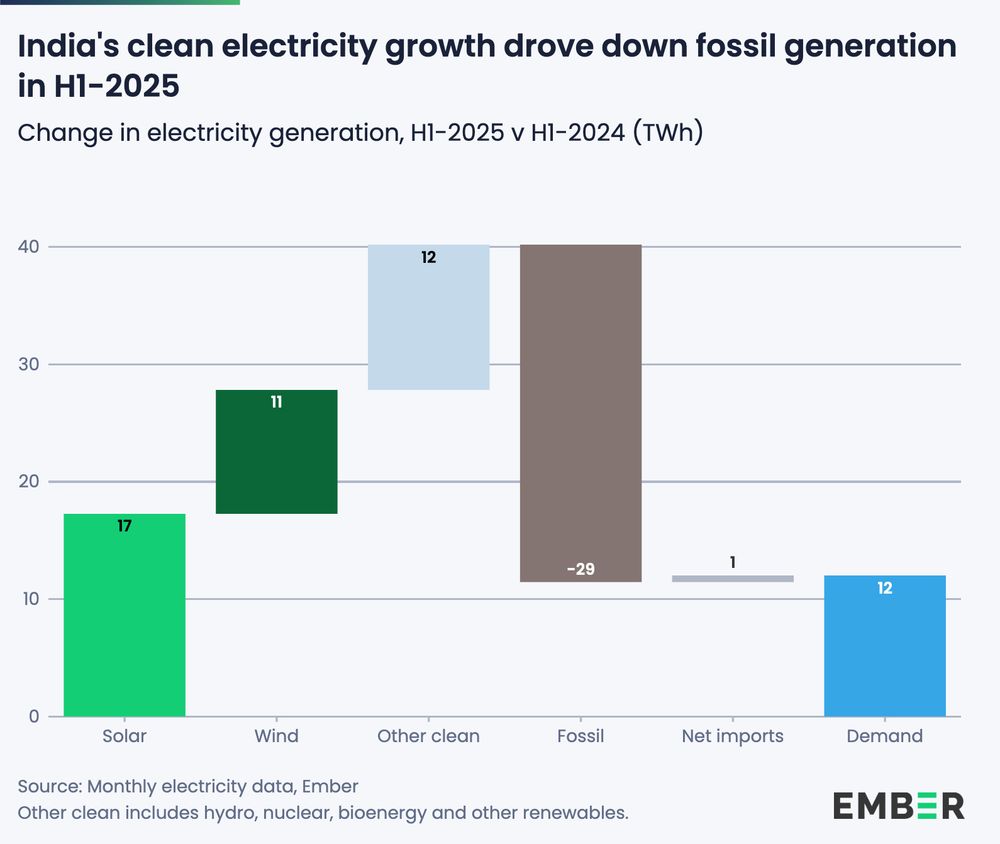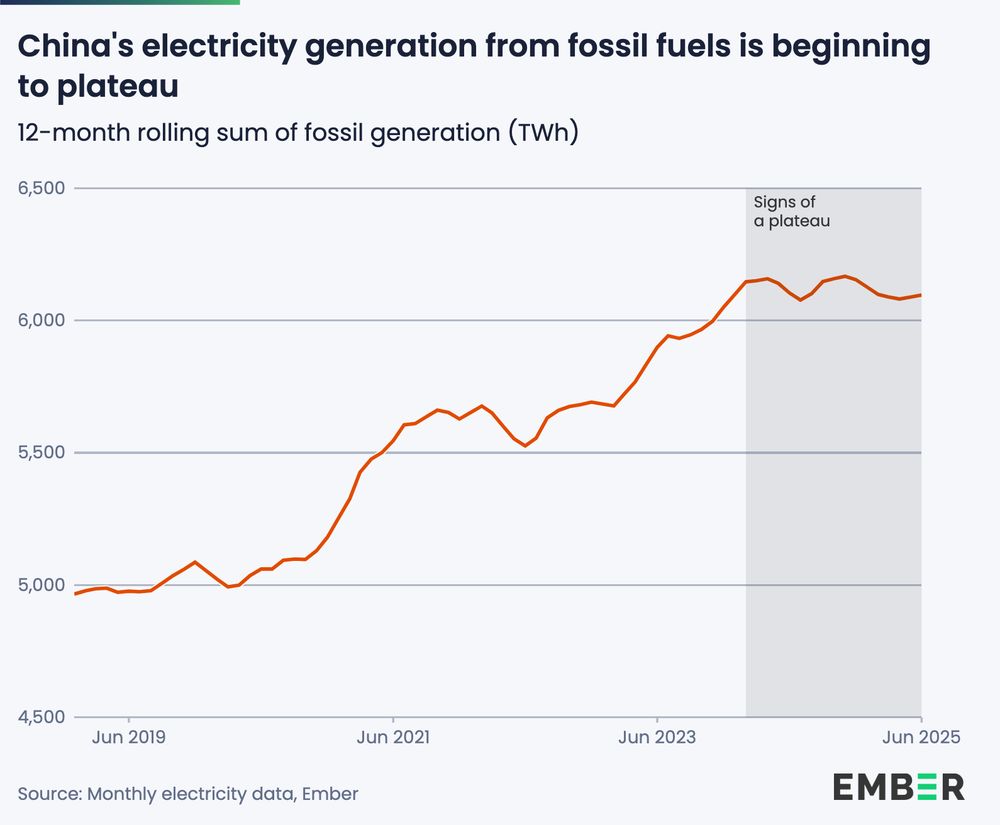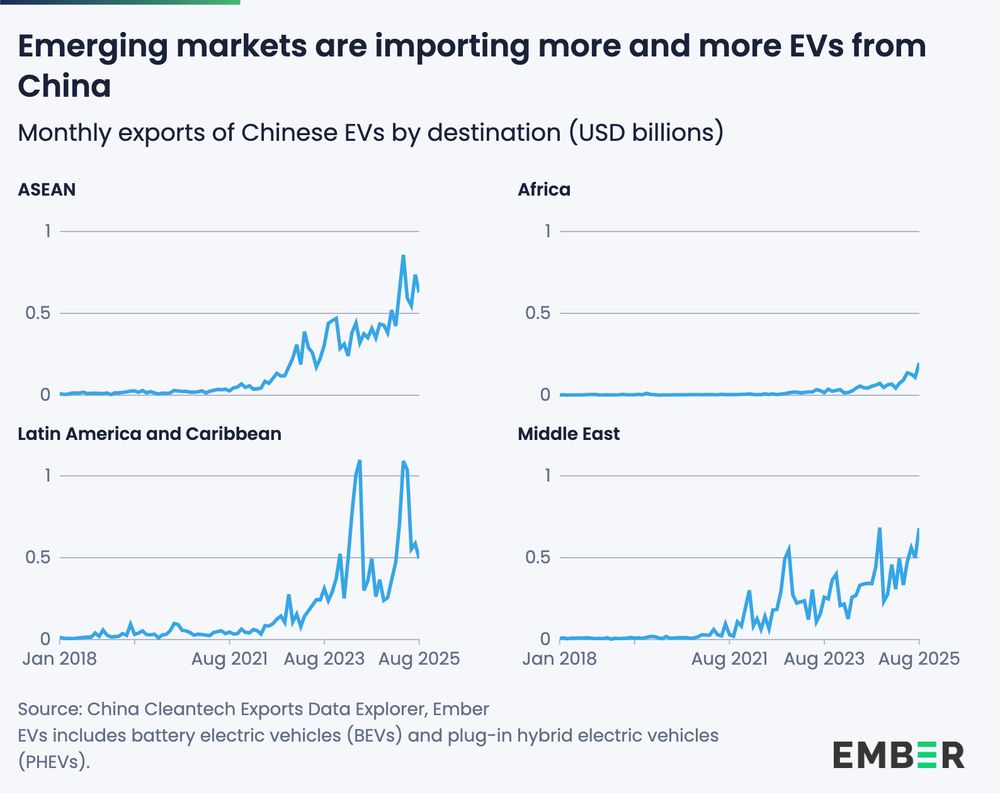
Finding, curating and explaining the data behind the global energy⚡️transition.
A 31% increase in Q1-Q3 2025, has pushed solar beyond the full year output for 2024, with three months left in 2025.

A 31% increase in Q1-Q3 2025, has pushed solar beyond the full year output for 2024, with three months left in 2025.
The yoy increase of 498 TWh in Q1-Q3 was three times larger than the next biggest increase from wind.
Solar's rise is in stark contrast to stagnating fossil generation.

The yoy increase of 498 TWh in Q1-Q3 was three times larger than the next biggest increase from wind.
Solar's rise is in stark contrast to stagnating fossil generation.
Combined with an increase in nuclear generation and falls in hydro power, fossil generation saw a minor decline in Q1-Q3.

Combined with an increase in nuclear generation and falls in hydro power, fossil generation saw a minor decline in Q1-Q3.
Ember forecasts no increase in fossil generation as wind and solar are growing fast enough to meet all new electricity demand.

Ember forecasts no increase in fossil generation as wind and solar are growing fast enough to meet all new electricity demand.
This was the first month ever where renewables have overtaken fossil fuels in Australia's electricity mix.
10 years ago, in October 2015, fossil fuels made up 86%.

This was the first month ever where renewables have overtaken fossil fuels in Australia's electricity mix.
10 years ago, in October 2015, fossil fuels made up 86%.
Year-to-date, coal power remains down 1.4%.

Year-to-date, coal power remains down 1.4%.
Batteries met a record high 37.2% of load at 6:25pm yesterday, Oct 12.
The share of load remained at >30% for two whole hours from 5:50 to 7:50 during peak demand and discharged late into the night, reducing gas and imports.

Batteries met a record high 37.2% of load at 6:25pm yesterday, Oct 12.
The share of load remained at >30% for two whole hours from 5:50 to 7:50 during peak demand and discharged late into the night, reducing gas and imports.
Solar is by far the fastest growing source of electricity in the EU, up 20% year-on-year.

Solar is by far the fastest growing source of electricity in the EU, up 20% year-on-year.
🏆 In September, wind and solar generation reached a share of 50.4%
Both wind and solar generation also reached new absolute output records for the month of September:
Wind: 7.7 TWh
Solar: 1.7 TWh

🏆 In September, wind and solar generation reached a share of 50.4%
Both wind and solar generation also reached new absolute output records for the month of September:
Wind: 7.7 TWh
Solar: 1.7 TWh
Renewables produced 5,072 TWh (34.4% share) in the first half of 2025 overtaking coal for the first time which stood at 4,896 TWh (33.1%.)

Renewables produced 5,072 TWh (34.4% share) in the first half of 2025 overtaking coal for the first time which stood at 4,896 TWh (33.1%.)
Solar was already at 8.8% of GLOBAL electricity generation in the first half of 2025, more than doubling since 2021 (3.8%). ☀️
I guess 30% is the new limit??
🇭🇺Hungary: 29.7%
🇬🇷Greece: 26.3%
🇳🇱Netherlands: 25.7%

Solar was already at 8.8% of GLOBAL electricity generation in the first half of 2025, more than doubling since 2021 (3.8%). ☀️
I guess 30% is the new limit??
🇭🇺Hungary: 29.7%
🇬🇷Greece: 26.3%
🇳🇱Netherlands: 25.7%
The difference now? Record growth in wind and solar generation.

The difference now? Record growth in wind and solar generation.
2024 saw record heatwaves push up cooling demand, but 2025 has been much milder. This moderated demand growth, sometimes even dropping below 2024 levels, a rare sight in India's steadily growing power sector.

2024 saw record heatwaves push up cooling demand, but 2025 has been much milder. This moderated demand growth, sometimes even dropping below 2024 levels, a rare sight in India's steadily growing power sector.

Fossil power has plateaued since early 2024 as solar and wind have been matching or growing faster than electricity demand.

Fossil power has plateaued since early 2024 as solar and wind have been matching or growing faster than electricity demand.
In China, low-carbon power growth from solar, wind (and some nuclear) was higher than the increase in electricity demand, despite a small fall in hydro generation. This led to a decline in coal.

In China, low-carbon power growth from solar, wind (and some nuclear) was higher than the increase in electricity demand, despite a small fall in hydro generation. This led to a decline in coal.
Coal generation dipped slightly compared to the first half of 2024, with renewables continuing to grow.

Coal generation dipped slightly compared to the first half of 2024, with renewables continuing to grow.
A fall in hydro negated some of the growth in solar, wind and nuclear, but fossil fuels still saw a small decline.

A fall in hydro negated some of the growth in solar, wind and nuclear, but fossil fuels still saw a small decline.
This marks a reversal from previous trends.
Simultaneously, there was a small uptick in the US and in the EU.
A thread 🧵

This marks a reversal from previous trends.
Simultaneously, there was a small uptick in the US and in the EU.
A thread 🧵


At the same time, the value of solar PV exports peaked in early 2023 as our new tool shows.


At the same time, the value of solar PV exports peaked in early 2023 as our new tool shows.


The export value of batteries is 4x higher than in 2020, the value of EV exports has grown 10x.

The export value of batteries is 4x higher than in 2020, the value of EV exports has grown 10x.

